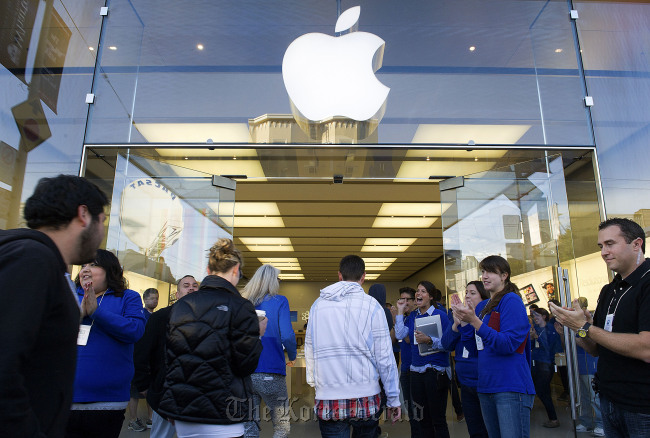Apple Inc.’s decision to create a smartphone that boasts a thinner, lighter touch screen contributed to the component shortfall that caused demand to outstrip supply of the iPhone on its debut weekend.
With the latest version of the iPhone, Apple is for the first time using so-called in-cell screen technology, which combines the display and the touch sensor into a single part. The components are made by LG Display Co. and Japan Display Inc.
Apple used the technology in the first major iPhone overhaul since 2010 to make the device more svelte, an attribute that helped lure a record 5 million buyers in three days. Yet producing in-cell screens is also more painstaking than earlier screen types, contributing to bottlenecks.
 |
Customers enter an Apple Inc. store to buy the new iPhone 5 in San Francisco, California, U.S., on Sept. 21. (Bloomberg) |
“This is like the opening weekend for the summer blockbuster movie,” said Tom Dinges, senior principal analyst at IHS ISuppli. “They needed to get a lot of products in the door during a tight window, and these supply constraints that were talked about probably did have some impact.”
The iPhone is Apple’s top-selling product, accounting for about two-thirds of its profits. A successful debut is critical for the company to maintain the growth that has led investors to make it the world’s most valuable company.
Apple had also enlisted Sharp Corp., Japan’s largest maker of liquid-crystal displays, to round out its suppliers and lessen reliance on longer-term partner LG Display. Yet the Japanese company is struggling to reduce defects in screens that include the new technology and was unable to start shipments before the iPhone debut, according to Barclays Plc.
LG’s constraints
Manufacturing enough of those parts for Apple has been challenging for LG and Japan Display, analysts at the London- based financial-services provider said.
“Apple is facing significant production constraints due to a move toward in-cell display technology,” Ben Reitzes, an analyst at Barclays, wrote in a research note on Tuesday. “Apple is struggling to keep up with demand.”
About 10 million units of in-cell panels will be available in the calendar third quarter, he said.
Miyuki Nakayama, a Tokyo-based spokeswoman for Sharp, which is based in Osaka, declined to comment, as did Trudy Muller, a spokeswoman for Cupertino, California-based Apple. Claire Ohm, a Seoul-based spokeswoman for LG Display, and Kazuhiko Kubota, a spokesman for Japan Display in Tokyo, also declined to comment.
Brian White, an analyst at Topeka Capital Markets, had estimated debut weekend sales of 6 million to 6.5 million units, excluding Internet purchases that haven’t been shipped.
Enviable ‘problem’
The supply constraints may be short lived, Dinges said. Because of the large sums Apple spends on components, the iPhone and iPad maker will be the first in line for parts, he said.
“It’s a problem that everybody else would love to have,” Dinges said. “Even if you are going to run in to some areas where there are supply shortages, Apple is going to to get a disproportionate amount of the available supply ― they are your best customer.”
Apple said it is working to catch up with demand.
“We are working hard to get an iPhone 5 into the hands of every customer who wants one as quickly as possible,” Apple Chief Executive Officer Tim Cook said in a statement. “While we have sold out of our initial supply, stores continue to receive iPhone 5 shipments regularly and customers can continue to order online and receive an estimated delivery date.”
Baseband Chips
The five previous iPhones released by Apple used three screens layered on top of each other: a LCD display that projects the images, a screen that senses a user’s tapping and pinching commands and a protective glass panel.
As manufacturing of in-cell screens improves, Apple may sell 45.2 million iPhones in the December quarter and 170.7 million through next September, Barclays said.
Another component that may be causing challenges is the new baseband chip that helps the iPhone 5 connect to LTE, or long- term evolution, wireless networks being introduced by mobile- phone service providers including Verizon Wireless and AT&T Inc. in the U.S. and Deutsche Telekom AG in Europe.
Qualcomm Inc., the biggest maker of chips for mobile phones, has said supplies of those parts have been constrained as it moves to a new manufacturing process to build them.
“If the yield is lower, then they may not be able to meet Apple’s order,” said Kyle Wiens, CEO of IFixit, which performs analysis of the components that are included in the iPhone and other consumer-electronics devices.
Emily Kilpatrick, a spokeswoman for San Diego-based Qualcomm, declined to comment.
Apple’s challenges go beyond components. A possible choke point is having enough people at Foxconn Technology Group facilities in China who can assemble the phones that eventually make their way to stores around the world, Wiens said.
“Ramping up to build another million phones isn’t an easy prospect,” Wiens said. (Bloomberg)




![[Herald Interview] 'Trump will use tariffs as first line of defense for American manufacturing'](http://res.heraldm.com/phpwas/restmb_idxmake.php?idx=644&simg=/content/image/2024/11/26/20241126050017_0.jpg)

![[Health and care] Getting cancer young: Why cancer isn’t just an older person’s battle](http://res.heraldm.com/phpwas/restmb_idxmake.php?idx=644&simg=/content/image/2024/11/26/20241126050043_0.jpg)

